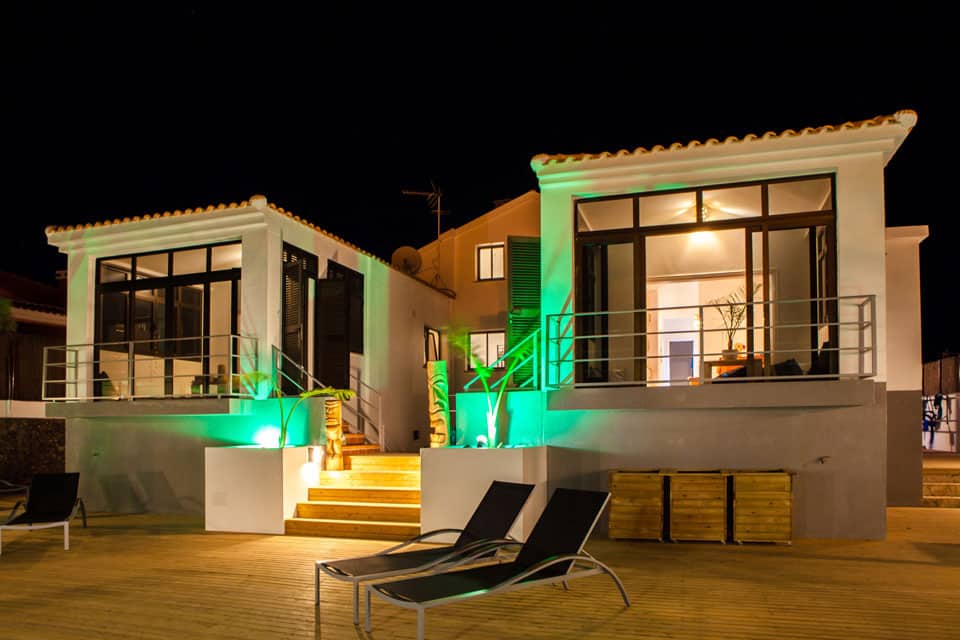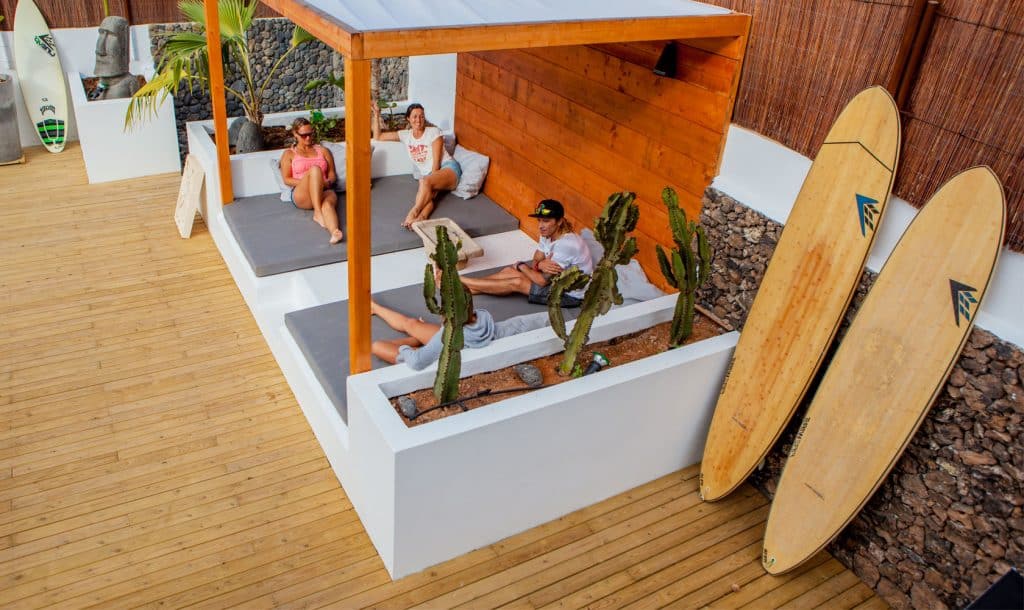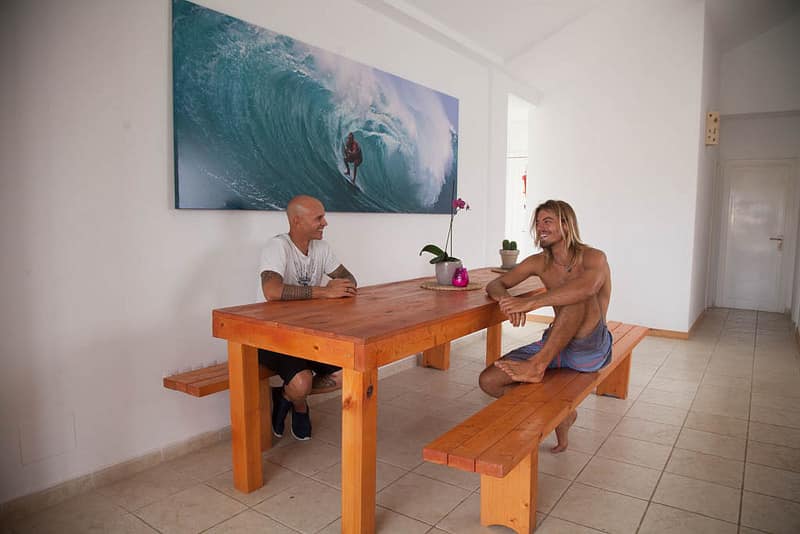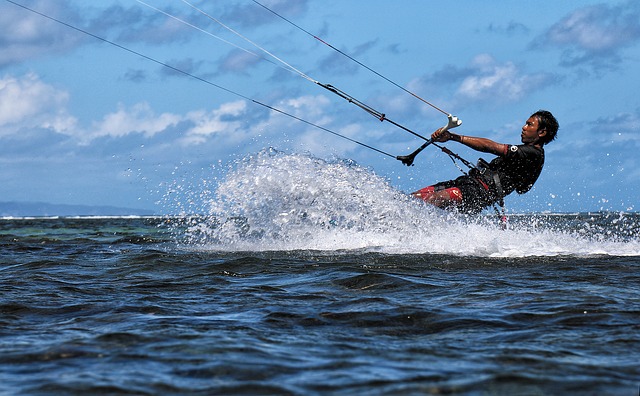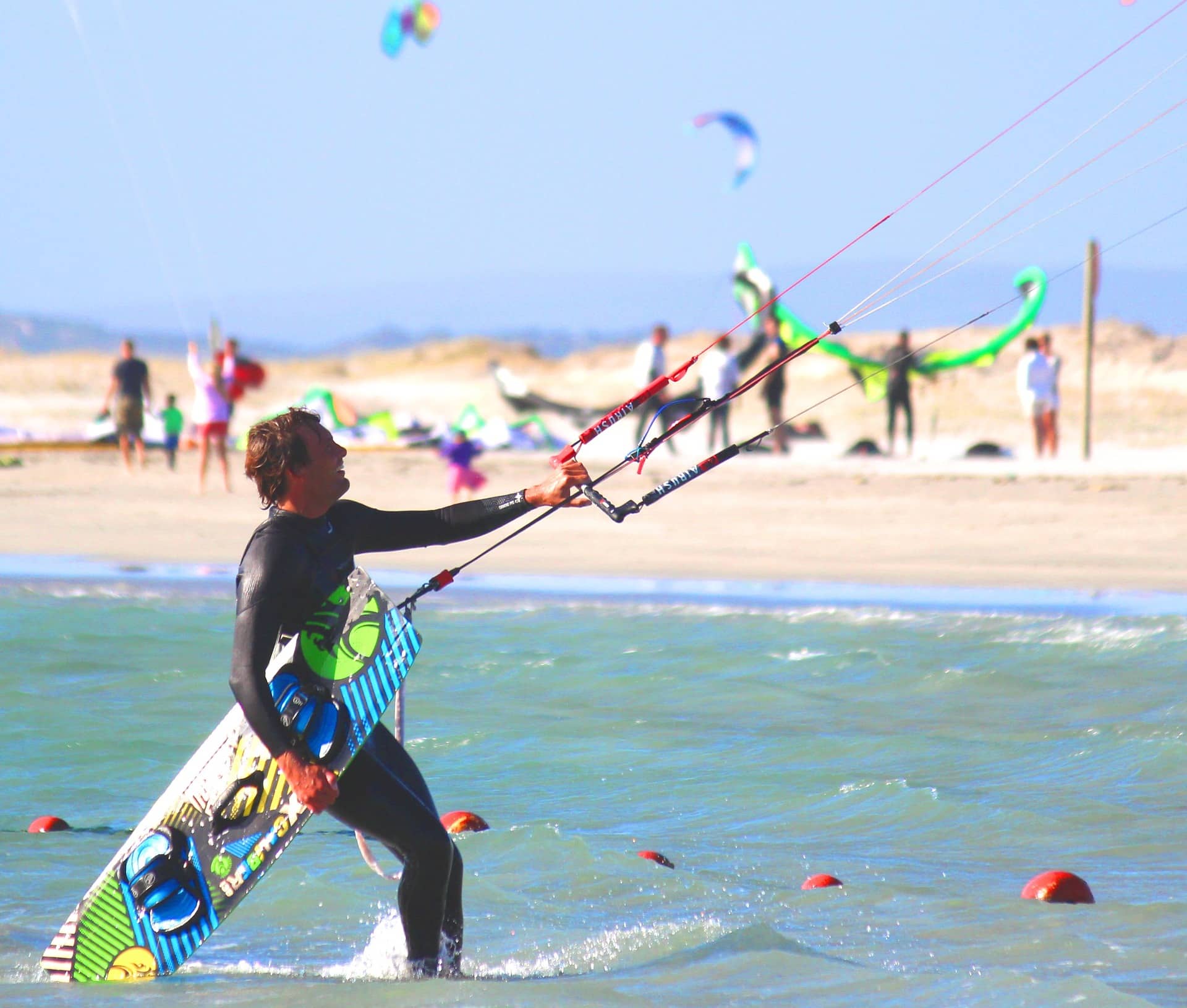Learn kitesurfing in Fuerteventura, Corralejo
The Fuerteventura Ocean Adventure kitesurfing school is located north of Fuerteventura, in the city of Corralejo, one of the best places to practice kitesurfing. As a test centre, our Kite school and its qualified instructors are the only kite school in Europe to offer you the opportunity to practice your favourite water sport with the best and latest equipment from the market leader’s brands.
The instructors at our surf school take you through all the stages of kitesurfing training in Fuerteventura, making sure you have a good time! Choose the formula that corresponds to your availability, your objectives and your budget.
At the end of your course with us, you will be ready for your Kiter life with solid technical and safety knowledge!
“Great! Great! Perfect conditions! Totally different from dahkla because there you go by boat and they let you go to sea (rather than start from the beach) and so you really have 2h-2h30 in the water!” Margaux of Paris
>> Fees Kite School & Camp Fuerteventura, Corralejo <<<
Our kitecamp is located in the north of the island of Fuerteventura in Corralejo. It is located a stone’s throw from the paradisiacal beaches and the Corralejo Natural Park. We offer you a comfortable and clean accommodation in a modern, spacious and elegant design.
Kitesurfing lessons for beginners step by step
Lesson 1
Learn – Kite School Surf Fuerteventura Corralejo
Kite Control & Safety: On the first day, you will learn how to control the kite on the beach, how to use the safety systems as well as basic weather and safety skills. “You’ll be ready for the boat ride.”
Lesson 2
Boat or Lagoon Session: Boat sessions start with body dragging, techniques to launch the kite into the water, followed by departures in the water and progression to your first trips. The boat follows you, always in eye contact, the instructor supervises your progress. Boat sessions allow you to progress quickly and safely.
It’s great to be able to ride straight ahead without obstacles and to get the most out of the kite experience. Jean Marc, Marseille
- Wind knowledge
- Kite preparation
- Security systems
- Power zone, launch and landing
Lesson 3
Repeat the basic practices: kite launches, starts in the water and descents in the wind, which optimizes the control of the kite and the board, possibly from the first ascents to the wind.
A chance to refine and improve the techniques learned in previous sessions under the supervision of experts.
Lesson 4
Let’s go for our first beach start session. First day, you learned to control the kite on the beach, second and third day, you progressed to your first trips on open water.
If the conditions are appropriate, we have the option to replace the boat session with a beach start session.
This is the time to learn how to properly prepare and organize your own beach. Leave and return safely from the beach by optimizing fast and smart progression.
Lesson 5
Beyond…… Together with the instructor and the other students, you will decide what the session will be like. With precise and tailor-made objectives, “These sessions will take you to the next level in your kite surfing journey.
Kitesurfing lessons for an Advanced Level
You know how to tack and go upwind. If you want to progress for jumps and their landing, learn strapless or foil, contact us!
A day without wind?
If there is ever a day without wind you can do other activities like SUP or surfing. You will then be given a voucher towards the end of the stay if you have not used the full kite package, you can use it to buy equipment or clothing in our surf shop, or keep it for later (valid for 18 months).
Be careful, normally travel insurance does not cover lack of wind.
Kitesurfing and Kiteboarding, what is it?
Kiteboarding is an action sport that combines the aspects of wakeboarding, snowboarding, windsurfing, surfing, paragliding, paragliding, skateboarding and sailing in a single extreme sport. A kiteboarder harnesses the power of the wind with a large kite of controllable power to be propelled through water, land or snow. On the water, we use a kiteboard, similar to a wakeboard or a small surfboard, with or without footstraps or bindings. Kitesurfing is a style of kitesurfing specific to wave riding, which uses standard surfboards or specially designed surfboards. On land, a mountain board or stroller is used, while skis or snowboards can be used in snow,
There are different styles of kitesurfing, including freestyle, freeride, speed, running, wakestyle, big air, park and surfing.
With the development of Internet markets for used items, used but reliable kitesurfing equipment has become much cheaper, significantly reducing the barrier to adopting the sport. In addition, the sport is very convenient for transport and storage, as the kites are foldable and the boards are smaller than most surf and paddle boards.
Compared to other sailing sports, kitesurfing is one of the cheapest and most practical. It is also unique in that it harnesses wind energy from a much larger atmospheric volume in relation to sail size.
In 2012, the number of kitesurfers was estimated by ISAF and IKA at 1.5 million people worldwide. The global market for kite equipment is valued at US$250 million.
Content
1 History
1.1 Jump records (height, length, time)
1.2 Speed records
1.3 Long distance
1.4 Notable travel
1.5 Bering Strait Crossing
1.6 Atlantic Crossing
2 Governance
3 Styles
4 Techniques
5 The wind
5.1 Wind strength and kite size
5.2 Wind direction and speed
5.3 Apparent wind
5.4 Wind energy, control lines and kite paths.
5.5 Window Window Window
5.6 Air temperature and humidity
6 Places
6.1 Maui, Hawaii
6.2 Tarifa, Spain
6.3 Cumbuco, Brazil
6.4 Nabq Bay, Egypt
7 Equipment
7.1 Power kites
7.1.1 Inflatable Leading Edge
7.1.2 Aluminium kites
7.1.2.2.1 Open cell
7.1.2.2.2 Closed cell
7.1.3 Kite sizes
7.2 Other equipment
8 Benefits of regular practice
9 Hazards and safety
9.1 Weather
9.2 Aggravating factors
9.3 Safety equipment
9.4 Statistics
9.4.1 Reports on human casualties
9.5 Safety rules for kitesurfing
10 Terminology and jargon
11 Market data
12 Kiteboarding against windsurfing
13 World Freestyle Ski Champions
History of the event
In the 1800s, George Pocock used larger kites to propel land carts and ships on the water, using a four-line control system – the same system commonly used today. The carts and boats were able to turn and sail upwind. Kites could fly for extended periods of time. The intention was to establish kitepower as an alternative to horse/steam, partly to avoid the hated “horse tax” that was levied at the time. In 1903, aviation pioneer Samuel Cody developed “lifting kites” and managed to cross the English Channel in a small folding canvas powered by a kite.
In the late 1970s, the development of Kevlar, followed by Spectra flight lines and more controllable and efficient kites, contributed to the practical traction of kites. In 1978, Ian Day’s “FlexiFoil” catamaran, powered by a kit, exceeded 40 km/h.
In October 1977, Gijsbertus Adrianus Panhuise (Netherlands) received the first patent for KiteSurfing. The patent covers, in particular, an aquatic sport using a floating surfboard type board where a pilot standing on the board is pulled by a parachute type wind pick-up device attached to his harness on a trapeze type belt. Although this patent did not generate any commercial interest, Gijsbertus Adrianus Panhuise could be considered as the initiator of KiteSurfing.
During the 1980s, there were sometimes successful attempts to combine kites with canoes, ice skates, snow skis, water skis and roller skates.
Throughout the 1970s and early 1980s, Dieter Strasilla from Germany developed the parachute ski and later perfected a kiteskiing system using gliders of his own manufacture and a swivel pivot allowing the pilot to sail upwind and uphill but also to take off in the air at will. Strasilla and her Swiss friend Andrea Kuhn also used this invention in combination with homemade surfboards and snowboards, lawns and strollers. One of his patents describes in 1979 the first use of an inflatable kite for kitesurfing.
Two brothers, Bruno and Dominique Legaignoux, from the Atlantic coast of France, developed kites for kitesurfing in the late 1970s and early 1980s and patented an inflatable kite design in November 1984, a design that was used by companies to develop their own products.
In 1990, Peter Lynn pioneered the practice of kite buggying at Argyle Park in Ashburton, New Zealand. Lynn has coupled a three-wheeled buggy with a precursor of the modern parafoil kite. Kite buggying has proved popular worldwide, with more than 14,000 buggies sold until 1999.
The development of modern kitesurfing by the Roeselers in the United States and the Legaignoux in France continued in parallel with the buggy. Bill Roeseler, a Boeing aerodynamic engineer, and his son Cory Roeseler patented the “KiteSki” system, which consisted of water skis powered by a two-line delta kite driven by a combined bar-mounted winch/brake. KiteSki was launched in 1994. The kite had a rudimentary launching ability and could go upwind. In 1995, Cory Roeseler visited Peter Lynn at Clearwater Lake in New Zealand’s Ashburton Alpine Lakes region, demonstrating speed, balance and leeward angle on his “ski”. In the late 1990s, Cory’s skiing evolved into a unique board similar to a surfboard.
In 1996, Laird Hamilton and Manu Bertin played a key role in the demonstration and popularization of kitesurfing off the Hawaiian coast of Maui while in Florida Raphaël Baruch changed the name of the sport of flysurfing to kitesurfing by launching and promoting the first commercial brand in the kitesurfing industry.
In 1997, the Legaignoux brothers developed and sold the revolutionary design of the “Wipika” kite, which had a structure of preformed inflatable tubes and a simple flange system at the wingtips, both of which greatly helped to boost water flow. Bruno Legaignoux has continued to improve the design of kites, including the development of the design of bow kites, which has been licensed to many kite manufacturers.
Since 1999, kitesurfing has become a mass sport with the arrival of the main windsurfing manufacturers, Robby Naish and Neil Pryde. One-way boards derived from windsurfing and surfing have become the dominant form of kitesurfing. Since 2001, twin-tip bi-directional boards have become more popular with most flat water runners, with directional boards still being used for surfing conditions.
In May 2012, the kitesurfing racing style was announced as a sport for the Rio 2016 Olympic Games, replacing windsurfing. However, after a vote by the ISAF General Assembly in November 2012 (Dun Laoghaire, Ireland), RSX windsurfing was reinstated for both men and women, an unprecedented decision when ISAF’s constituent members reversed a decision taken by the ISAF Council. Kitesurfing therefore remains a non-Olympic sport until 2020 at the earliest. The ISAF biannual meeting in May 2013 proposed to seek an eleventh medal to include kitesurfing in 2020, while a commitment was made to keep the other 10 existing classes as they are for 2020 and even 2024, including RSX windsurfing for men and women.
Kitesurfing has been designated as an official event of the 2018 Summer Youth Olympic Games in Buenos Aires.
Jumping record (height, length, time)
Nick Jacobsen reached the world record for the highest kite jump measured by WOO Sports on February 19, 2017 in Cape 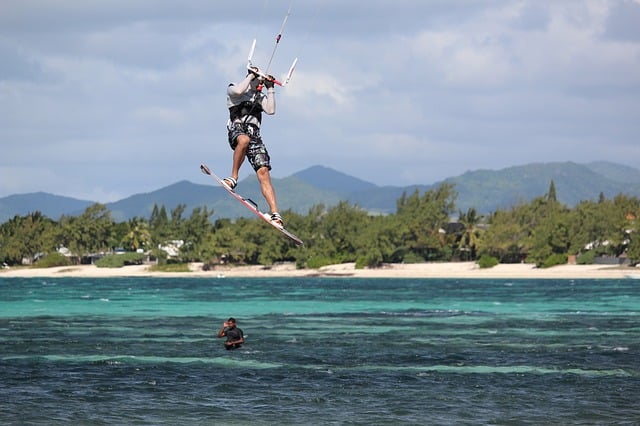
Jesse Richman holds the suspension time record of 22 seconds, set at Crissy Field in San Francisco, California.
Speed record
French kitesurfer Sébastien Cattelan became the first navigator to cross the 92.6 km/h mark, reaching 93.08 km/h on October 3, 2008 at the Lüderitz Speed Challenge in Namibia. On October 4, Alex Caizergues (also from France) broke this record with a descent of 93.66 km/h. Similar speeds are reached by windsurfers at the same place by Anders Bringdal and Antoine Albeau, respectively 93.46 km/h and 93.69km/h. These speeds are verified, but are still subject to ratification by the World Sailing Speed Record Council. Earlier in the event, on September 19, American Rob Douglas reached 92.30 km/h, becoming the first kiteboarder to set a world speed record. Previously, the record was only held by sailboats or surfers. Douglas also became the world’s third fastest navigator at over 92.60 km/h when he drove a 93.60 km/h race on September 8.
On November 14, 2009, Alex Caizergues completed another 94.41 km/h race in Namibia.
In October 2010, Rob Douglas became the record holder for the 500-metre short distance record at 103.06 km/h. Sébastien Cattelan became the record holder in France and Europe with 102.77 km/h and was the first rider to reach 101.86 km/h.
On November 13, 2017, French rider Alex Caizergues became the new holder of the world speed record in France (Salin de Giraud) reaching 107.36 km/h.
Noteworthy trips
Louis Tapper made the longest kite trip ever recorded, covering 2000 km between Salvador and Sao Luis, Brazil. The trip was completed between July/August 2010 and lasted more than 24 days of kitesurfing. This trip is also the longest solo trip, without a support crew, with a kite and a 35-litre backpack…
The longest recorded kite trip was that of Eric Gramond who made a 13-day trip over 1450 km along the Brazilian coast.
Bering Strait Crossing
Constantin Bisanz, a 41-year-old Austrian, crossed an 80.47 km stretch of the Bering Strait from Wales, Alaska, on August 12, 2011 at 4 am and arrived in eastern Russia two hours later, after which he returned by boat to Alaska. It occurred after two unsuccessful attempts, the first on July 28, 2011, during which it was floating in water at 36°F without a board, kite or GPS for one hour before being rescued. On his second attempt on August 2, he and two friends covered half the distance before turning around due to poor wind conditions.
Crossing the Atlantic
A team of six kitesurfers, Filippo van Hellenberg Hubar, Eric Pequeno, Max Blom, Camilla Ringvold, Ike Frans and Dennis Gijsbers crossed the Atlantic Ocean from the Canary Islands to the Turks and Caicos Islands over a distance of about 5,600 km, from November 20, 2013 to December 17, 2013. Each of the six spent four hours a day surfing, divided into two sessions of two hours each, one during the day and the other at night.
Governance
Kiteboarding has undergone many changes in the governance of sport on the world stage. Currently, all World Cup events are sanctioned by the International Olympic Committee via World Sailing. World Sailing then shared governance between the Global Kitesports Association (expression disciplines) and the International Kiteboarding Association (running disciplines). The GKA then split the expression disciplines, choosing to run the Wave and Strapless Tour themselves, while allowing the World Kiteboarding League to run freestyle and the Kite Park League to run in the park.
Styles

Freeride
Freeride is everything you want it to be and the most popular style of kitesurfing. Most of the boards sold today are designed for freeriding. It’s about having fun and learning new techniques. Twintip boards and kites with good relaunch and a wide range of wind are commonly used.
Free style
The kite and board are used to get big air (jumps) so that various tricks can be done in flight. This style is also used for competitions and is free format and “go anywhere”. Smaller twintip boards and kites with a good boost and hangtime are used.
Wave-riding
Wave riding (kitesurfing) in the waves is a style that combines kiteboarding and surfing. Places where there is a wave breaker are required. Most kitesurfers use a directional board (with or without foot straps) that has enough waterline and turns to surf the wave. Many kiters use a surfboard that can also be used for regular surfing (with the foot straps removed). The kitesurfer follows the kite in the wave, which reduces the kite’s traction. This style is popular with surfers because it looks like tow-in surfing. Some riders ride on stalled waves, and without foot straps. The foot straps dictate the position of the kitesurfer’s foot and how weight and pressure are applied to the board. Surfers (other than tow surfer) do not wear straps and are therefore free to move their feet and position their weight over a larger area of the board to match what is necessary to flow with the wave. Kitesurfing using a board without foot straps is called “strapless ride”. This allows the kitesurfer’s feet to move around the board for optimal performance. Kitesurfers using foot straps often use the power of the kite to position themselves on a wave and to control their board. That is, they rely on the kite for propulsion rather than the power of the wave to surf.
Wakestyle
Tips and acrobatics, using a wake style board with fasteners. May also include figures and jumps involving ramps. Wakeboarding crossover. The flat water is perfect for this style, and the use of large twintip boards with high rocker and wake booties is common. This style is commonly practiced by young riders.
Show jumping or Airstyle
Jumping, which is probably a subset of Freeride, consists of jumping high to perform optional tricks, sometimes also using kiteloops to get extra waiting time. Often, shorter lines and smaller kites are used in stronger winds. C-shaped kites and twintip boards are commonly used. An extension of this style is Big Air, pioneer of Ruben Lenten, where runners go out in gale force conditions and perform high-risk movements such as kiteloops or more precisely megaloops.
Wakeskate
Wakeskaters skaters use a double-ended strapless board, similar to skateboarding. Still water and other similar conditions in Wakestyle.
These are running events – like a sailing race along a course, which involves both speed and tactics. Special directional race boards with long fins are used. Some racing boards look like windsurfing boards. Aluminium foil panels are also used. The objective is to outperform the other kiters and go first in the race.
Windsurfing board
Speed race
Speed running is a style practiced either at official running events or informally, usually with GPS devices. Special directional speed boards or racing boards with long fins are used. The objective is to move at the maximum possible speed over 500 metres.
Park riding
Park riding is like wakestyle. Riders use wakeboard obstacles to perform tricks on them. Difficulty, execution and style
Techniques
Kitesurfing can pose risks to surfers, swimmers, passers-by and others on the water. Many problems and dangers that can be encountered when learning to kite can be avoided or minimized by attending professional courses in training centres. Kitesurfing schools offer courses and lessons to teach skills, including launch, flight, landing, use of bar, lines and safety devices. Core competencies include:
Jump
Big Air
The turn, especially the jibe “heel turn”.
Controlled flight and jumping, the main attractions of the sport.
The board grabs, the figures performed while a rider jumps or has gained air by grabbing the board in a number of positions with either hand. Each grab has a different name depending on the part of the tray that is gripped and the hand that grips it. The names generally come from other sliding sports such as skateboarding and snowboarding.
The wind
Wind force and kite size
Kitesurfers change size and/or line length depending on wind strength – stronger winds require a smaller kite to avoid overpower situations. Kitesurfers will determine wind strength using an anemometer or, more typically, visual cues as shown on the Beaufort scale. Modern kites dedicated to kitesurfing offer a “Depower” option to reduce the power of the kite. By using the Depower, the wing’s angle of attack with respect to the wind is reduced, which allows less wind to be caught in the wing and reduces power or traction.
Bow kites have a wider wind range than C kites, so two sizes of kites (such as 7 m² and 12 m²) could form an effective quiver for winds ranging from 10 to 30+ knots for a 75 kg rider.
Wind direction and speed
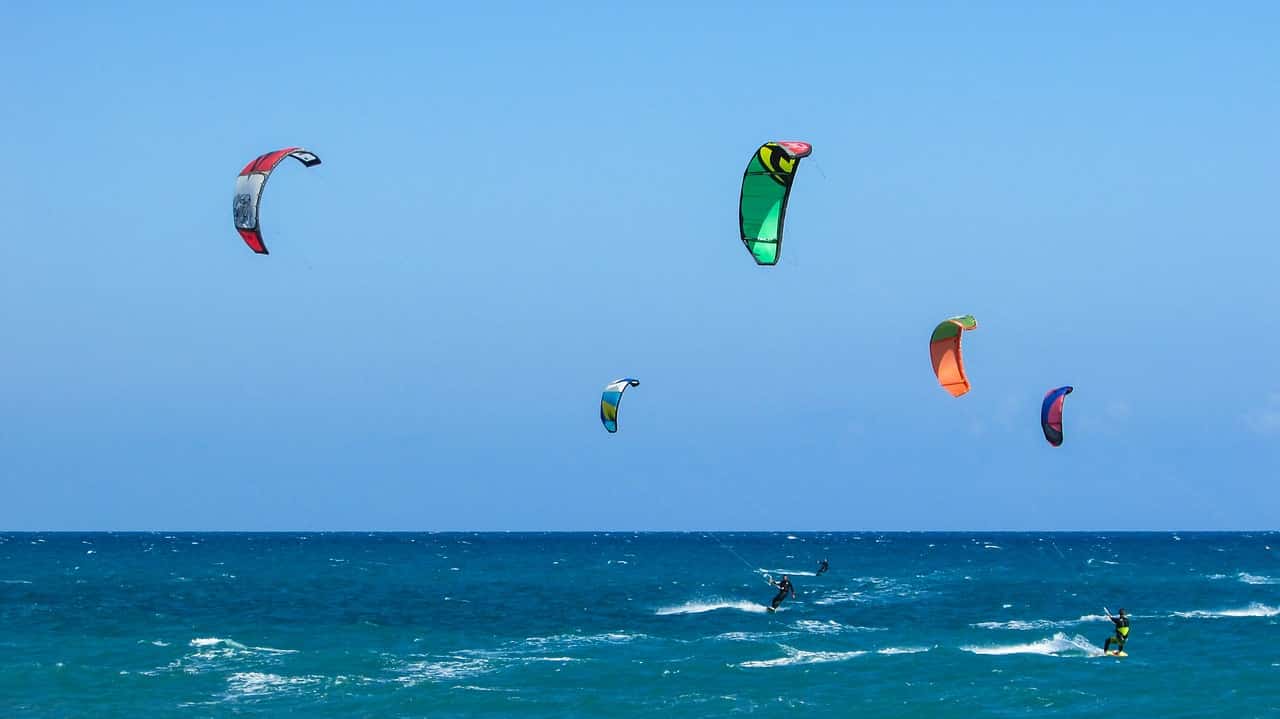
The kiter must maintain a clear perception of the wind direction but also of the wind speed. The Beaufort scale is a great help to help users assess the situation. A wind range of up to 33 knots covers the conditions for a safe practice for an experienced runner. A less experienced sailor should avoid sailing at more than 15 knots. Most twintip boards and inflatable kites would be barely travelling below 11 knots, so in most cases a user would have to focus on moderate to strong winds.
Apparent wind
Even if there is no wind, a kite can act on the lines of the kite and force it to move, and then, as with a row, it generates a certain force resulting from the incidence of air in the surface of the kite. In a light breeze, if the user’s action increases the air speed around the kite 10 times, the force generated increases 100 times, since the wind force acting on a kite is proportional to the square of the wind speed acting on it. Hence the relevant notion of apparent wind, which is the real wind acting on the kite, sail or wing in motion.
The apparent wind is measured by taking the moving kite as a reference frame, so it is another name for relative wind. In contrast, the wind measured in relation to the ground is called the true wind.
While other wind sports can generate considerable apparent wind, their wind forces are limited by the movement of the user’s platform, since it is more or less rigidly attached to the wing or sail. In this aspect, kitesurfing seems unique among other wind sports, since it allows the user to generate apparent wind regardless of the movement of the user’s platform, the board. For example, in the kiteboard starting technique called waterstart, while the user is preparing to start in the water, the kite is sent aggressively, generating a propulsive pulse. Then, the resulting movement of the board increases the tension on the kite lines, which the user controls to manage speed and navigate at will. The composition of the kite and board movements offers the user great flexibility in navigation and creativity, including the ability to jump significantly, making it a true three-dimensional sport.
Wind energy, control lines and kite trajectories
In a way, all wind sports collect the energy of the wind. The more the volume of the atmosphere is available to be collected by the sails, the greater the energy available to propel the users. As a taller sailboat collects more energy from the wind, so does a kitesurf with longer lines. Compared to a kiteboarder, a windsurfer can extract a higher ratio of wind energy from the available atmospheric volume, but as this volume is much smaller, the resulting energy could be much lower than in kiteboarding.
To increase power, the kitesurfer typically sails along an S-shaped path, which increases the energy harvest as it passes through most of the volume of the atmosphere around it. This S-shaped movement is most common when kiters need a moderate improvement in power. If the user needs an intense improvement in power, he closes the wing. Such loops are stronger when the radius of the loop is large, and pass through a larger volume of atmosphere. The kite loop is an advanced practice, and its power can be very dangerous. With most modern kites and control bars, to complete a kite loop, the user pushes or releases the bar.
With regard to the length of the lines connecting the wing to the user, longer lines allow the user to collect wind energy in a larger volume. Due to the boundary layer effect, longer lines also allow stronger winds to be picked up higher in the atmosphere. But the longer lines make the kite slower to respond to the user’s actions on the control bar, since the lines form a more pronounced pring-like catenary. This is why kitesurfers, who must react quickly to incoming waves, tend to use shorter lines than other kitesurfers. For safety reasons, newcomers to the sport are usually trained with short lines, which limits the accumulation of power.
Wind window
The wind window is the 180-degree arc of the sky to the lee of the rider in which the kite can fly – about a quarter of the surface of a sphere, whose radius is the length of the lines. This is the volume of the atmosphere in which the kite can fly to harvest wind energy.
If the rider is facing the wind on a surface, such as the ocean, the wind window covers almost the entire area that the rider can see, from the rider’s peripheral vision on one side, along the horizon to the other side, then directly above the head to the first side. If the rider puts the kite through the window – for example, by flying too fast downwind and sending the kite directly over and behind, the kite will often stall and fall from the sky.
The possible ineffectiveness of the wing can prevent it from reaching the edge of the wind window. In such cases, the amplitude of the wind window can be reduced to an arc of 120 degrees instead of the 180 degrees expected.
The wind window is centered where the user is located. Since the user is carried by the board, the wind window is affected by the movement of the board. As a result, the wind window rotates as the board moves and generates apparent wind in itself.
For example, when the kiter sails perpendicular to the actual wind at a speed equal to that of the actual wind, the apparent wind felt on the board increases by 42% compared to the actual wind, but turns 45º against the movement. With such a rotation, even if the user keeps the kite at the edge of the wind window to try to keep it in the direction of travel, the lines of the kite would be at a 45º angle downstream of the board’s path, forcing the kite on board to counter its tendency to slide downstream. Such a board edge is an essential technique for sailing upwind, and can be done at a much more extreme angle to the kite lines, almost up to 90º.
The rotation of the wind window degrades performance when driving fast in a windward trajectory. To minimize the rotation of the wind window and sail upwind as much as possible, the kiter should keep the board speed as slow as possible without causing the board to sink due to lack of hydrodynamic lift. High flotation boards such as surfboards are preferable in such cases. Also, keeping the kite high in the window, pulling the user and the board, is very effective in coping with both the reduction in the hydrodynamic lift of the board and the expected reduction in the speed of the board.
Temperature and humidity of the air
Experienced kiteboarders often attribute humid and warmer air to a significant reduction in wing performance. In fact, the lifting force of a kite is proportional to the density of the air. Since temperature and relative humidity are important harmful factors in air density, the subjective evaluation of kiters is correct.
In the range between 10ºC and 40ºC, a kite loses about 0.4% of lift per degree Celsius. This means that a kite flying on a given day in the Baltic and then flying to the Mediterranean could experience 10% less traction using the same kite at the same wind speed.
Places
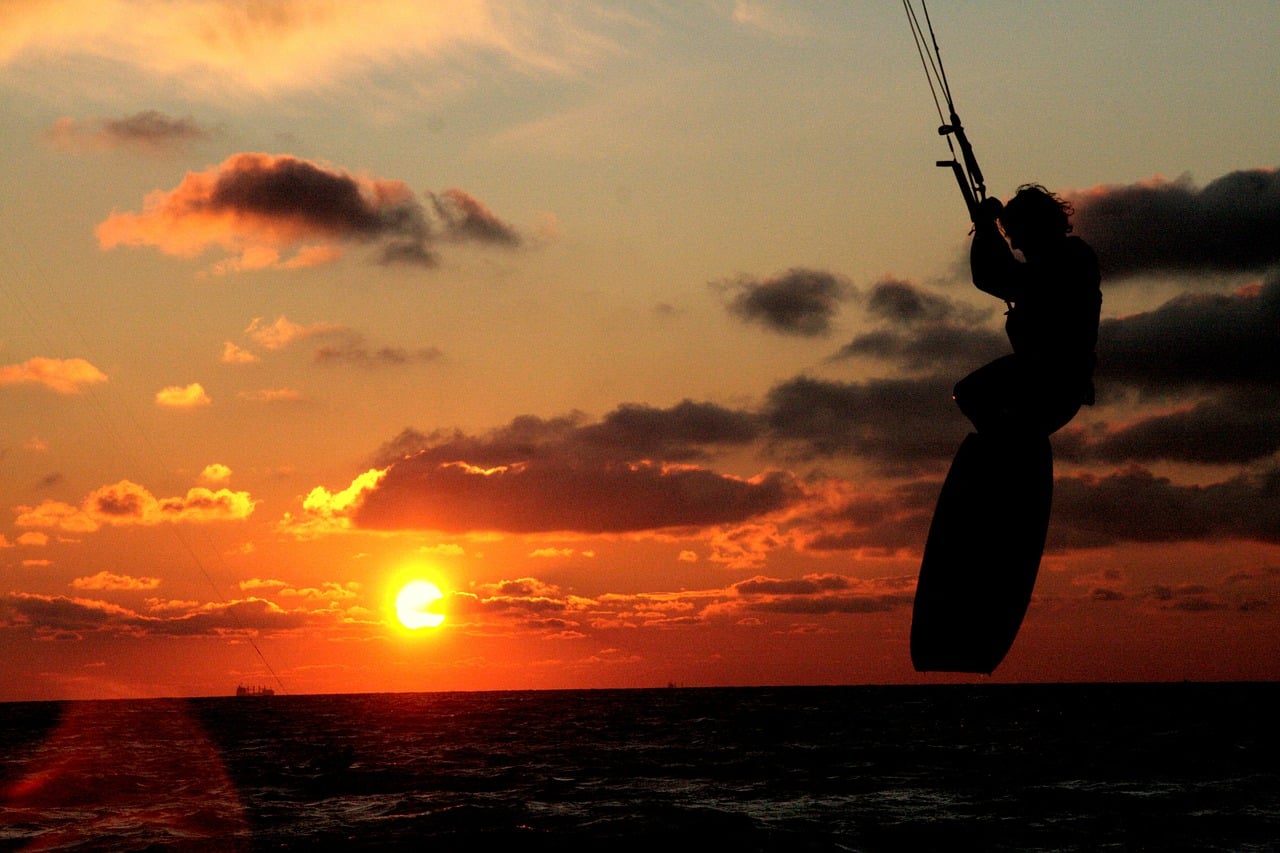
Any place with regular and regular crosswinds (10 to more than 35 knots), large open water bodies and good launching areas is ideal for kitesurfing. Most kitesurfing is practiced along the shores of the ocean, usually off the beaches, but it can also be practiced on large lakes and creeks and occasionally on rivers. Since kitesurfing is largely based on favourable and constant wind conditions, some places tend to become popular and sought after by kitesurfers.
Maui, Hawaii
Maui is considered one of the best kitesurfing destinations in the world. The tropical beach Kite Beach has warm waters, steady winds and soft waves.
Tarifa, Spain
Tarifa is a 10 km long bay with a wide beach of fine sand. The city of Tarifa is located at the NE end of the beach. There are different places along the entire length of the beach. Wind conditions vary depending on the time of year, but the wind is generally more constant from May to October.
Cumbuco, Brazil
With a strong daily crosswind and a wide sandy beach, Cumbuco deserves its nickname of “Kite Paradise”. The best season is from August to December, but January and February can also be good.
Nabq Bay, Egypt
It is a beautiful beach town, with shallow, flat waters, the wind blows at least 20 knots most days.
Equipment
Power kites
Illustration of the LEI(R), Bow(L) and Foil(T) power kites.
A motorized kite is available in two main forms: leading edge inflatable kites and foil kites.
Leading edge inflatables
Leading edge inflatable kites, also known as LEI kites, are generally made of ripstop polyester with an inflatable plastic bladder that extends over the front edge of the kite with small separate bladders that are perpendicular to the main bladder to form the rope or leaf of the kite. The inflated bladders give the kite its shape and keep the kite floating once in the water. LEIs are the most popular choice among kitesurfers because of their faster and more direct response to pilot requests, their ease of launching in the event of a fall into the water and their resilience. If a LEI kite hits the water or ground too hard or is subjected to high wave activity, the bladders can burst or tear.
In 2005, Bow kites (also known as LEI flat kites) were developed with features such as a concave trailing edge, a shallower plane-shaped arc and a distinctive flange with multiple attachment points along the leading edge. These characteristics allow the wing angle of attack to be further modified and therefore the amount of power generated to be adjusted to a much higher degree than previous LEIs. These kites can be completely depowered, which is an important safety feature. They can also cover a wider wind range than a comparable C-shaped kite. The ability to adjust the angle of attack also makes them easier to restart when they are lying down first on the water. Bow kites are popular with riders from beginner to advanced level. Most LEI kite manufacturers developed a variant of the bow kite in 2006. Arc kites with a straight trailing edge are called ´delta´, due to their triangular contour.
The first bow kites had some disadvantages compared to the classic LEI kites:
They may reverse and not fly properly.
They may be tense and less stable.
A heavier pressure bar makes them more tired of flying.
No boosting effect of the sled during jumps.
In 2006, the second generation of LEI flat kites was developed, which combine almost total power and easy and safe take-off with higher performance, without performance penalties and reduced bar pressure. Called hybrid kites or SLE (Supported Leading Edge), these kites are suitable for both beginners and experts.
In 2008, Naish introduced another kite design, with their “Sigma Series” kites. These kites are SLE designed and have a unique “bird in flight” shape with the centre of the wing swept backwards to put a large part of the sail area behind the towing point, which Naish says has multiple advantages.
In 2009, the performance revolution showed no sign of slowing down. The flanged designs are more like C kites, and the five-line hybrids have a better depower capability than ever before. There are more than 30 companies that manufacture advanced inflatable kites. Delta kites have become more and more popular since 2008 with a dozen companies offering delta kites since 2008/2009.
Between 2009 and 2013, kite technology continued to develop. Kites have become lighter, more durable, easier to launch and safer. Manufacturers have continued to add new safety features. This has resulted in an increasing number of new runners, young and old. In 2013, there are at least 20 “major” kite manufacturers, each with several models available. Many manufacturers are in the third or fourth generation of kites.
Aluminium foil kites
Foil kites are also mainly made of fabric (nylon ripstop) with air pockets (air cells) to give it lift and a fixed strap to maintain the shape of the kite’s arch, similar to a paraglider. Aluminum kites have the advantage of not having to have manually inflated bladders, a process that, with an IED, can take up to ten minutes. Leaf kites are designed with an open-cell or closed-cell configuration.
Open a cell
Open-cell films rely on a constant air flow against the intake valves to stay inflated, but they are usually impossible to restart if they touch the water, as they have no way of preventing deflation, and quickly become soaked.
Closed cell
Closed cell films are almost identical to open cell films, except that they are equipped with inlet valves to keep the air in the chambers, thus keeping the kite inflated (or at least making deflation extremely slow) even once in the water. Water relaunches with closed cell kites are simpler; a regular tug on the power lines usually allows them to take off again. An example of a closed cell kite is the Arc Kite.
Kite sizes
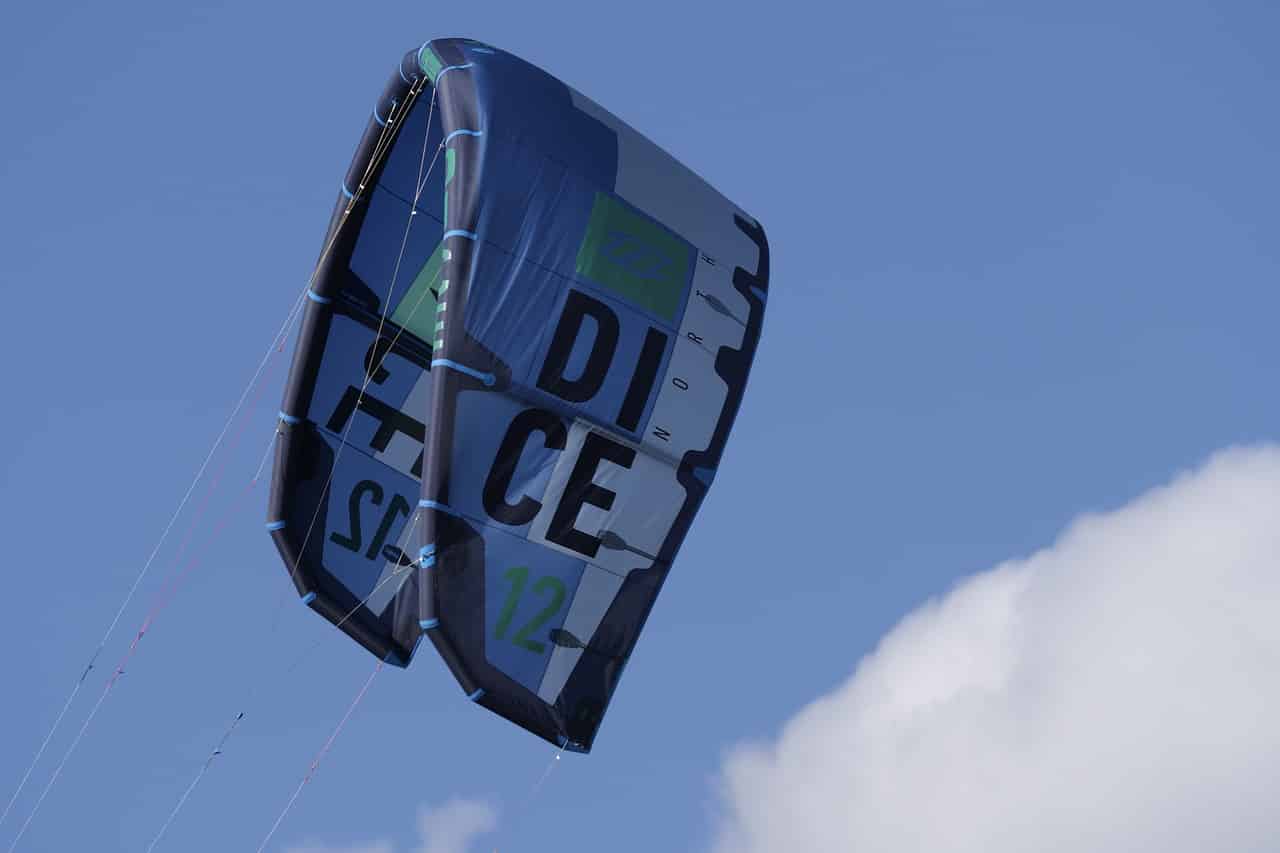
Kites are available in sizes ranging from 0.7 square metres to 21 square metres or more. In general, the larger the surface area, the more powerful the wing. The power of the kite is also directly related to speed, and smaller kites can fly faster in stronger winds. The wind speed curve the size of a kite becomes thinner, so going to a larger kite to reach lower wind ranges becomes futile at a wind speed of about eight knots. Kites are available in a variety of models. Some kites are more rectangular in shape; others have more tapered ends; each design determines the flight characteristics of the kite. The’aspect ratio’ is the ratio between reach and length. High aspect ratios (ribbon-shaped kites) develop more power at lower wind speeds.
Experienced kites will probably have three or more sizes that are needed to adapt to different wind levels, although bow kites can change that, as they have a huge wind range; some advanced kites use only one bow kite. Smaller kites are used by light pilots, or in strong wind conditions; larger kites are used by heavier pilots or in light wind conditions. Larger and smaller kitesurfers have the same effect: with more power available, a given rider can ride a smaller board. In general, however, most kiteboarders only need one board and one to three kites (7-12 m2).
Other equipment
The flight lines are made of a solid material such as very high molecular weight polyethylene, to support the dynamic load in unpredictable winds while maintaining a small cross-sectional profile to minimize drag. They are generally between seven and thirty-three metres long. Experimentation with line lengths is common in kitesurfing. The lines attach the rider’s control bar to the wing, using tie cords on the edges of the wing or its bridle. Most power kites use a 3, 4 or 5 line configuration. Most control rods have 4 lines, 2 for most propulsive power and 2 for steering and angle of attack control. The 5th line is used to help restart or adjust the kite’s angle of attack, especially in C-kites.
The control bar is a solid or composite metal bar that is attached to the wing via the lines. The rider clings to this bar and controls the wing by pulling on its ends, which makes the wing turn clockwise or counter-clockwise like a bicycle. Typically, a chicken loop of the control bar is attached to a lock or hook on a spreader bar of the rider’s harness. Most bars also offer a quick release safety system and a control strap to adjust the minimum wing angle of attack. The control bars of the kite, although light and strong, are generally heavier than water; foam “bar floats” can be attached to the lines just above the harness to prevent the bar from sinking if it is lost in the water. The control rods can be specific to a particular type and size of wing and cannot be used with different types of wings.
A kite harness comes in the seat (with leg loops), waist, or vest types. The harness and a spreading bar attach the rider to the control bar. The harness reduces the tension of the wing’s traction on the pilot’s arms by spreading it over part of the pilot’s body. This allows the rider to perform jumps and other tricks while remaining attached to the kite via the control bar. Belt harnesses are the most popular harnesses among advanced riders, although harnesses allow kitesurfing with less effort on the part of the rider, and jacket harnesses provide both flotation and impact protection. Kitesurfing harnesses are similar to windsurfing harnesses, but with a different construction; a windsurfing harness is likely to fail when used for kitesurfing.
Kiteboard, a small composite panel, made of wood or foam.
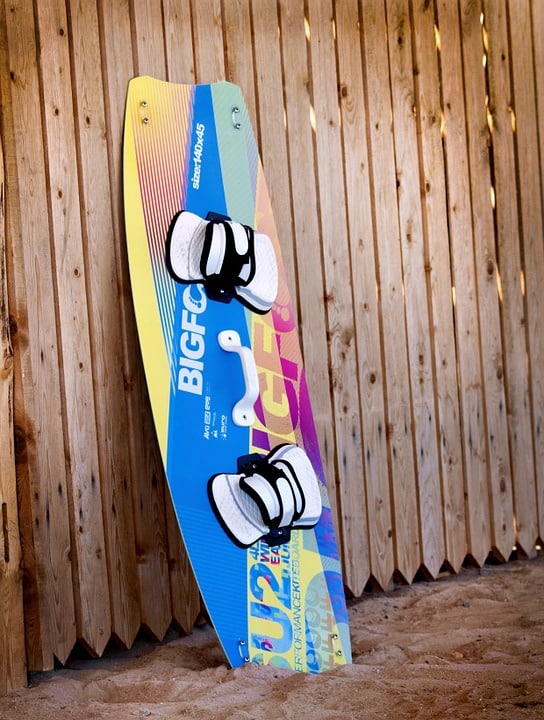
A wetsuit is often worn by kitesurfers, except in warmer conditions with light winds. When kitesurfing in strong winds, the loss of body heat is reduced by wearing a wetsuit. A “shortie” is worn to protect the torso only, and a full suit is used to protect against cold conditions, marine life such as jellyfish, and also against abrasions if the rider is dragged by the kite. Neoprene boots are required if the beach has a lot of shells or hard rocks. Dry suits are also used for kitesurfing in cold winter weather.
A safety hook knife is considered to be required equipment. The corrosion-resistant stainless steel blade is partially protected by a curved plastic hook. It can be used to cut tangled or hooked kite lines, or to release the wing in the event of a failure of the safety release system. Some kitesurfing harnesses are equipped with a small pocket for the knife.
A helmet is often worn by kitesurfers to protect the head from blunt trauma. Helmets prevent head lacerations and can also reduce the severity of head impact injuries, as well as compression injuries to the neck and spine.
A personal flotation device or PFD may be required if the kiteboarder uses a boat or personal watercraft as a support. It is also recommended for deep water kitesurfing in case the kitesurfer becomes disabled and has to wait for help.
A bumper vest provides some protection against chest impacts. They also provide some flotation and prevent the harness from climbing to the chest and injuring the ribs during high power manoeuvres.
A board leash that attaches the board to the kitesurfer’s leg or harness is used by some riders. However, many kitesurfing schools discourage the use of the board leash because of the risk of recoil, where the leash can tear the board off to hit the rider, which can result in serious injury or even death. Generally, kitesurfers who use a board leash will also wear a helmet to help them protect themselves from this.
Signalling devices are useful if the kitesurfer needs to be rescued. It can be as simple as a whistle attached to the knife or a retro-reflective tape applied to the helmet. Some kitesurfers carry a mobile phone or two-way radio in a waterproof pouch for use in an emergency. A small emergency position indicating radio beacon (EPIRB) can be carried and activated to send a distress signal.
A buddy is important to help launch and recover the wing, and to help in case of an emergency.
A GPS can be used to measure distance travelled, trajectories and speed during a session.
Benefits of regular practice
Kiteboarding is considered a medium to high intensity physical practice, but freeriding can actually be a low intensity practice like walking, and is generally done in long sessions of 2 to 3 hours. It is suitable for almost all ages, at least for adolescents up to 70 years of age or older. It can be considered as a supplement or substitute for other fitness practices.
Regular kitesurfing can bring very specific benefits such as:
Complete physical training.
Development of the coordination of body movements.
Consolidation of swimming capacity and adaptation to the aquatic environment, currents, waves, etc.
Mindfulness, because the practice releases endorphins and requires constant attention, developing the ability to concentrate the mind in the present moment, and to recover from daily stress, which also helps the immune system.
Develops community skills because practitioners need and have many opportunities to share experiences and help each other. It is quite common and even a standard of sport etiquette for unfamiliar people to help each other and share their experiences. And it’s not just during those dreadful summer breaks, where everyone sits side by side in front of the seaplane, exchanging anedoctes while waiting for the wind to rise.
Develops attitudes towards the environment, since regular treatment and dependence on nature itself is undoubtedly an excellent education in respect for the environment.
Develops perseverance and character in the face of challenges. While not because nature itself surprises and challenges even the most experienced rider, kiteboarding encompasses a vast set of different variations and modalities, each with its own new specialized tricks and nuances.
Inspires practitioners to travel to new places and look at known places from new perspectives, such as freeriding along the coast as opposed to driving a car on the coastal road.
Hazards and safety
Power kites are powerful enough to pull the rider like a wakeboard boat and raise their users to diving heights. An uncontrolled kite can be dangerous, especially in harsh environments. A runner may lose control due to a sudden drop or gust of wind, which can occur in the presence of strong winds due to squalls or storms (“colard”).
It is possible to be seriously injured after being swept away, dragged, carried away, carried away, blown downwind or dotted, resulting in a collision with hard objects such as sand, buildings, terrain or power lines or even hitting the water surface with sufficient speed or height (“kitemare”, a kite and nightmare coat rack). Adequate quality professional training in kitesurfing, careful development of experience and constant use of good judgement and safety equipment should reduce kitesurfing problems.
Weather forecast
Weather forecasting and awareness are the main safety factor for kitesurfing. Lack of knowledge and understanding of the figures is common, but weather problems can be avoided. The choice of inappropriate locations for kitesurfing where the wind passes over the ground creating shade to the wind, the rotor with gusts and pronounced lulls has also been taken into account in many accidents. Paying attention to the weather and staying within the limits of runners’ abilities will provide the safest experience. Kitesurfing near storm fronts can be particularly dangerous due to rapid changes in wind strength and direction.
Aggravating factors
The lack of a sufficient leeward buffer distance between the kiter and hard objects contributed to reducing the available distance and reaction time. It can be dangerous to jump and get outdoors in inappropriate places such as shallow water or near fixed or floating objects. Collisions with windsurfers, other kitesurfers or boats are dangerous, especially in high traffic areas.
Solo kitesurfing has been a frequent cause of accidents; kitesurfers should try to kitesurf with friends and keep an eye on others. A kitesurfer can move further away from the shore than an easy swim, which is the main reason why kitesurfing in directly offshore winds is discouraged. Marine hazards include sharks, jellyfish, sea otters, dolphins and even crocodiles, depending on the location. Drowning has also been a factor in serious accidents and may have been prevented in some cases through the use of an appropriate flotation device or lifejacket and the development of acceptable swimming skills.
Security equipment
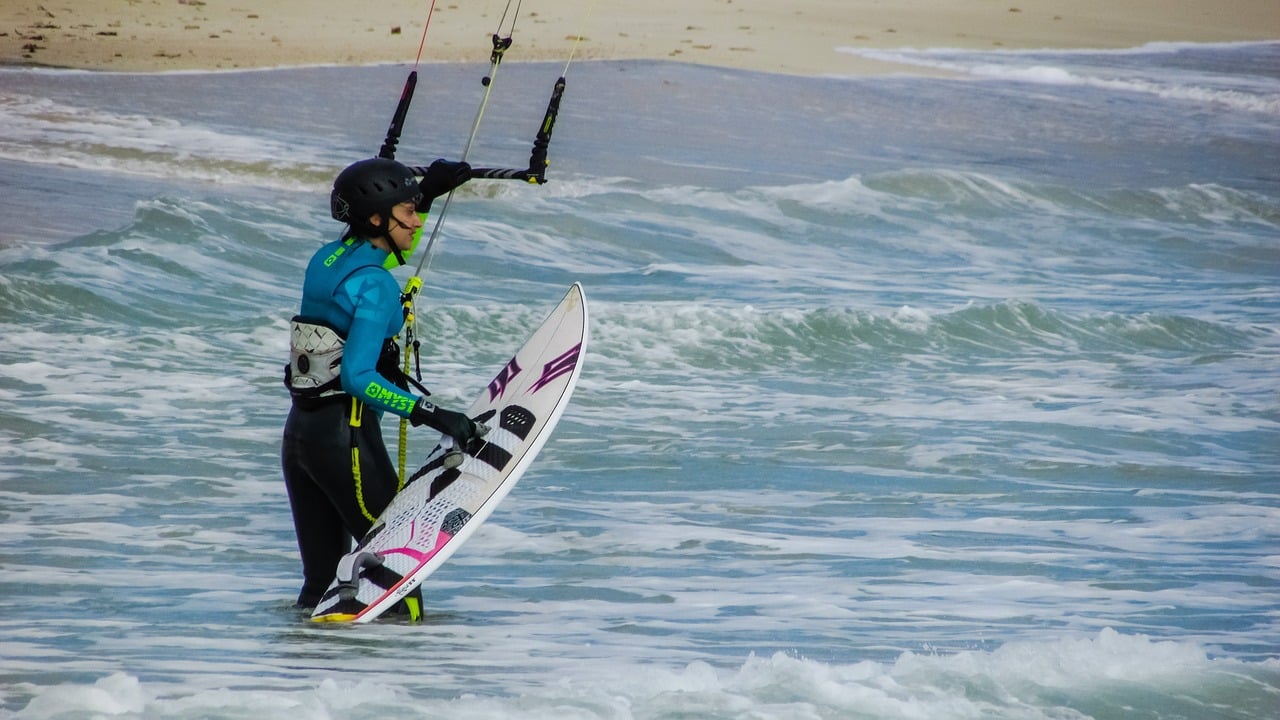
Another important part of the safety equipment is the bumper vest, which also serves as an improved flotation device. It reduces the severity of potential impacts, but also improves the user’s endurance in long deepwater self-rescue procedures, which almost all freeride kiter experience sooner or later. It is also important and neglected as a supplement to the harness, preventing it from climbing along the chest during powerful kite loops, which would otherwise injure the ribs.
Other important parts of a reasonable safety kit are the safety hook knife to cut tangled lines, the helmet in a high visibility colour, a diving suit of reasonable thickness, depending on the water temperature, and possibly neoprene boots if the beach has lots of shells or hard rocks.
Statistics
Accidents can result in serious or even fatal injuries. 105 accidents were reported in the Kiteboarding Safety Information Database between 2000 and September 2003, with 14 deaths. In South Africa, between October 2003 and April 2004, 83% of search and rescue missions involving kitesurfing were in offshore winds with the kite still attached to the harness, uncontrolled in strong winds or impossible to launch again in light winds. In 30 missions, no one was killed, but five were injured: two suffered bone fractures after being hit by their boards, two others suffered from critical hypothermia and exhaustion.
Safety rules for kitesurfing
While some countries have specific regulations on kite flying that can also apply to kitesurfing, most do not. However, a kitesurfer should comply with the navigation rules that govern boats in many countries, such as U.S. Coast Guard regulations. Developed from these generic rules, a set of rules or recommendations specific to kitesurfing has been in place since the beginning of the sport.
The first of these rules is the prudential rule: with so many people discovering water sports, a kiter should not assume that others have the knowledge, training or even an adequate attitude, and be prepared to observe self-preservation distances and always let others clearly perceive his intentions and his planned path.
Water scooters have priority: the runner who leaves the beach always has priority over the runners who enter.
High kite rule – A kite that is upwind (closest to the wind) must keep its kite high to avoid crossing the lines of leeward kites. Similarly, the leeward kite must keep its kite low to prevent its lines from crossing leeward kites. This applies regardless of whether the kitesurfers are on the same course or on opposite courses.
Clearance rule – A jumping kiter must have a safety zone at least 50 m downwind because it will move downwind during the jump. A rider must also have a 30m safety zone in the wind to jump because his lines could touch the wing or the lines of another kiteboarding rider nearby (see the Kite High rule). It is important to consider potential dangers to the lee and crosswind of the cyclist, such as people, buildings, trees and other fixed obstacles. Due to the clearance rule, a jumper is never allowed to pass.
Kiters are also considered sailing yachts – so all standard sailing rules apply, such as :
Starboard Ruler – When the kite women approach from opposite directions, the kiter with the wind on the starboard side (right side, right leg/right arm leads in the direction of travel) has the right of way. The kiter with the wind on the port side (left side, left leg/left arm are wires in the direction of travel) must stay away from the other. In simple terms, this means “keep right”, the kiter coming in the opposite direction through the left.In terms of navigation, a sailor or kiter with a right of way has the right to “insist” on exercising this right (warn opposing kites) by shouting “starboard” clearly and in time.
Many of the navigation rules of the right-of-way are different expressions that the most manoeuvrable boat should give way to the least manoeuvrable boat. Therefore, kitesurfing should be replaced by fishing boats, but not by jet skis. Other recreational boating rules such as no-go areas, shoreline distance and swimmers also apply. The surfing rules also apply, so that, for example, a rider who wants to catch a wave closer to the ridge has the right of way even if he is not on a starboard tack edge, including freeriders.
Terminology and jargon
Air time: the time spent in the air while jumping. This can be remarkably long; the record is Jesse Richman’s 22-second long jump. Five to ten seconds is not unusual.
Apparent wind: speed of the wing in relation to the ambient air. When the kitesurf is in a straight line, the apparent wing wind is a combination of wind speed and wing speed on the surface, but since the wing is very steerable, the apparent wind can vary considerably depending on how the wing is flown. Most ways to increase the power of the wing involve giving it a higher apparent wind, i.e. plunging the wing, rolling faster, or rolling at a larger angle in the wind. Any of them increases the apparent wind speed of the kite.
Retreat: A condition in which the wing stops moving forward in the air and becomes difficult to control, often causing the kite to retreat and crash. The stall of the back is often caused by the lack of wind or by the flight of the kite with too wide an angle of attack.
Big air: make a high jump using the lift of the wing. The jump is often assisted in its initial phase by the rider who is catapulted from the lip of a wave.
Body dragging: being pulled into the water without standing on a board. This is a first step in the learning process, and it is essential before trying the board after flying a training kite.
Boost: suddenly becoming airborne
Small brains: to forget which turn you intended to perform in the air and which eventually crashed or landed on the water.
Charlie Browner: same as kiteboarder or kitesurfer.
Chicken loop: a hard rubber loop attached to the centre line that has been passed through the control bar. It is used to attach the control bar to the harness so that the kitesurfer can produce tension in the lines using the full weight of the body instead of using arm force.
Chicken bone / chicken finger / donkey dick: a hard rubber “tongue” attached to the chicken loop that the rider passes through the hook of the spreading bar to prevent the rider from “unhooking”.
De-power: to reduce the power of the wing (traction), usually by adjusting the angle of attack of the wing. Most kites and control bars now allow a rider to rig a kite for a number of different power levels before launching it, in addition to raising and lowering the kite “on the fly” by moving the bar up and down. Reliability makes a kite safer and easier to handle. Some new models of kites, especially bow kites, can be unloaded to almost zero power, giving them a huge range in the wind.
DP: Dawn patrol; one morning session.
Downstream: the direction towards which the wind blows; downwind. When a runner is facing the tailwind, the wind is at his back.
Downwinder: a kitesurfing trip (which can be as short as a few minutes) where the rider starts at one point and ends at another point downwind of his initial position.
Edge: inclination of the board with its edge in the water. Allows to control the direction of travel. It is essential to learn to do well to excel in order to learn to tack with the wind. Tucking is one of the fundamental skills of kitesurfing and it is one of the ways that kitesurfing is different from windsurfing or wakeboarding. While windsurfing boards have daggerboards and/or skegs to steer the board in the wind while the board itself provides lifting and planing, kitesurfing boards generally combine both functions and the bottom of the board lifts the rider and steers simultaneously.
Facial: total loss of control of the kite on the beach, which means that the harnessed rider is dragged the first face downwind on the rocks and sand.
Freeride: kiteboarding style. Simple kiteboarding that does not involve tricks or jumps. The main objective is to keep a good tack and the ability to cross upwind. This would normally require a board with a small rocker.
Freestyle: kiteboarding style. The free style involves figures (or combinations of figures) where the rider jumps from the water and experiences an improved elevation using the lift generated by the kite. The free style is, from a weather point of view, a multi-condition concept and is, to some extent, specific to the equipment. “Big Air” is commonly associated with freestyle.
Goofy: the rider’s foot, with the right foot at the head.
Guinea pig: a person who goes out to test whether the wind is practicable or not. If so, others start riding too. Also known as Wind-dummy.
Heel side: the side of a board on the edge where the runner’s heels are located (opposite the toe side). “Riding heel side” is rolling with your heels down.
Hindenburg: (reference to the 1937 Hindenburg Airship disaster) a kite falling out of the air due to the loss of tension in the control lines, and therefore the loss of control of the kite. Hindenburging can be caused either by the lack of wind or by the kite moving forward to a windward position of the kitesurfer in the wind window, also called “kite flying over”.
Handlepass: when unhooking, pass the control bar behind a runner and come back into the air.
Hot Launch: Recovery and launch of the wing from a deep position within the wind window so that the wing is immediately at maximum power (potentially dangerous).
Kiter: the person who drives the kite.
Kiteloop: it is a group of motorized tricks where a rider closes the wing through the power zone.
Kitemare: a kiteboarding accident or a dangerous accident. Kitemares can be deadly.
Launch: launch of the kite. The kite can be launched with or without assistance. An assisted launch is generally safer than an unassisted launch.
Lofted: to be lifted vertically into the air by the kite due to a strong gust of wind. Stacking resulted in death when kites on or near land were dragged into obstacles. The danger can be avoided by minimizing the time spent on land with the kite flying directly above the head, and by not flying a kite in situations of overpower.
Luff: when the air flow stops around the kite. He can then pick up and fall from the sky. Like sails, a luff kite has corrugated and beaten panels. When launching the wing, if the wing is luffing, the rider must move further upwind, or the person holding the wing must move downwind.
Mobe: this term has two meanings: either a class of wakestyle figures involving an inversion with 360 degree rotation, or a specific figure involving a rear roll with a 360 degree front handle (while keeping the wing below 45 degrees). The first meaning comes from the second, which was the first type of mob to be unloaded. Other types of mopeds include: 540 moped, 720 moped,
Nuking: wind blowing at high speed (30-40 knots). These extreme conditions are dangerous for most runners.
Offshore: wind blowing on the water from shore. Never sail in the wind without a means of recovery, i.e. a tracking boat. It’s a little less important in small bodies of water, of course.
Onshore: wind blowing perpendicularly and directly from the water to the shore. A difficult condition for beginners, especially if waves are present.
Dookie dive: loss of power during flight time resulting in a crash in the water.
O-Shit loop: two loops at both ends of the bar that are attached to the lines of the kite and pass through the rings attached to the bar. A standard leash attachment point.
Air waves: waves of two metres or more (6 feet) or more from trough to crest;
Overpowered: the condition to have too much power of the wing. May be the result of an increase in wind, a bad choice of kite (too big for the conditions), an incorrect setting, a too fast speed, etc. It is interesting to note that experienced riders who are overpowered can switch to a smaller board to compensate, to some extent, although it is common to have only one board.
Pop: height gained above the water using only the board and the tension in the lines to lift, the wing being generally positioned at 45 degrees. Lower kite angles are possible for more experienced pilots. Used as a basis for many tours and considered an essential skill to progress.
Port side: on the left side of a vehicle, as perceived by a person on board facing the bow (front).
Power up: when the wing power increases (suddenly), due to wind gusts or wing movement.
Power zone: this is the area of the sky where the wing generates the most lift (pull), it is generally between 0 and 60 degrees from the centre of the tailwind direction.
Re-launch: general term for lifting the kite up into the air after it has crashed (on land or water). A restart is not assisted and requires the runner to follow a procedure specific to the kit (see manual). Over the years of development, the newest kites are easier to relaunch.
Knight: kiteboarder.
Self-rescue: A manoeuvre by which a rider with a land-based kite manipulates the kite in the water to help it swim to shore. The rider usually rolls up his lines until he reaches his kite, then positions his kite so that it is on his back as if he were carried on land, but with the tip of the wing closer to the shore to catch the wind. This wing tip acts like a sail and helps to pull the rider towards the shore. This is considered an important manoeuvre to learn.
Send it: to move the wing aggressively upwards through the power zone.
Schlogging: this is a very low-powered motorcycle. A rider has no power to glide and certainly not enough to jump. A rider and his board bounce off the surface planing with drag in the water.
Shit hot: the art of fluid and elegant movements.
SLE: Supported Leading Edge. A C-shaped kite with an inflatable leading edge, currently the most advanced kite design available to massively reduce power.
Offshore side: wind blowing between the coasts and at an angle of 45 degrees to the coast.
Land side: wind blowing between the coasts and at an angle of 45 degrees to the coast.
Lateral shoreline: winds blowing parallel to the shoreline. Usually the most desirable direction for kitesurfing.
Spreading bar: a stainless steel bar that attaches to the rider’s harness. It has a hook that holds the chicken loop when hanging.
Starboard side: the right side of a vehicle as perceived by a person on board facing the bow (front).
Stomp: to succeed in a trick.
Surfstyle: Waves using surfboards. The ideal conditions are crossing the shoreline to cross the open sea with the wind blowing in the same direction as the wave breaks. The boards can be mounted with or without foot straps.
Tack: the direction in which you sail, normally either starboard tack or port tack. In a starboard tack, the wind comes from the starboard side (to the right) of the runner, as if it were a boat. In normal navigation, the kitesurfer takes a course as close to the wind as possible and, in any case, leads to a certain angle slightly upwind, sometimes up to 45 degrees; jumps or waves usually cause leeward movements, so the net result is to maintain a relative position. Alternatively, see “downwinder”.
Tea bag: getting out of the water and back into the water intermittently due to light or gusty winds, poor piloting, twisted lines, etc.
Toe side: the side of a board on the edge where the runners’ toes are located (opposite the heel side). “Riding toe side” is rolling with your toes down.
Underpowered: the condition to have insufficient power of the wing. May be the result of insufficient wind, choice of a kite too small for the wind, incorrect rigging, too small a board, a water current in the same direction as the wind, insufficient speed, etc. A rider who continuously dives the kite and sends it back in sinusoid is usually malnourished.
Unhooked: this is when a kitesurfer kitesurfing while the chicken loop is not attached to the rider’s harness.
To the wind: the direction from which the wind blows; to the wind; to the wind; to the wind; in the wind.
VaS conditions: Victory at sea; rough sea conditions characterized by high wind waves causing severe breakwaters.
Wakestyle: A style of kitesurfing in which the rider usually uses wakeboard (or kiteboarding) boots for his board (as opposed to straps and pads), ensuring that his feet remain firmly attached at all times (henses the term “Wakestyle”). This style is also associated with performing motorized figures with the kite as low as possible on the water (which is generally perceived by kitesurfers as more difficult and elegant).
The Walk of Shame: walk on the beach upwind to where the kite was originally launched. This could mean that the kiter was not able to sail upwind.
Wind: person who goes out to check whether the wind is practicable or not. If so, others start riding too. Also known as guinea pig.
Zenith: the location in the wind window directly above the kiter head. This is the neutral position where kitesurfers can place the kite to stop moving or before movement. This places the wing in a more vulnerable position in the “Hindenburgs” position than any other.

